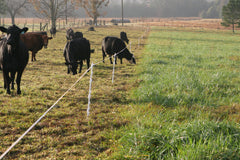Electric Fencing for Rotational Grazing
Posted by Gallagher Fencing at
Owning livestock and ensuring for its proper care can be quite expensive. Not only is the care expensive, but the long term impact can be a vital key in the profitability of your herd, be it livestock for beef, for milk, or simply for hobby. For those who have the property to properly house their cattle ensuring that they are securely kept in a pasture, capable of providing adequate feed is a must to being cost efficient. One of the best ways to save is by the proper use of rotational grazing. The practice of rotational grazing first grew in popularity with sheep and goat farms, but has more recently become more and more common in horse and cattle operations as well.
Once you make the decision to implement rotational grazing with your cattle it is especially important to ensure that you are monitoring the pasture growth to ensure that you are putting your herd into a pasture during its prime grazing time. Putting them in too late or leaving them too long will be detrimental to the pasture as well as to the nutritional value the herd is able to acquire (USDA). By implementing an effective rotational practice you will ensure that your herd is fed well, and your pasture maintains itself with little intervention.
Why Electric Fencing?
 There are multiple ways to set up and maintain a rotational program; however, it is most effectively done with electric fencing. This can be either a permanent or a temporary fence set up according to your personal needs. Electric fence is economical, flexible, and easy to install in multiple terrains as well as safe for your livestock.
There are multiple ways to set up and maintain a rotational program; however, it is most effectively done with electric fencing. This can be either a permanent or a temporary fence set up according to your personal needs. Electric fence is economical, flexible, and easy to install in multiple terrains as well as safe for your livestock.
The key to successfully implementing a rotational grazing program for your herd is to make sure that you are using an adequate power supply to charge the fence. You will find that most electric fence charging systems are ranked by mileage, while this is important information, more importantly, you’ll also want to ensure that you are checking that the system is a minimum of one joule per five acres. More acres, means more joules to keep the charge moving adequately; this is to ensure that the fence has a consistent voltage throughout its entirety vs having low voltage areas that could lead to your herd finding a way out of its pasture. The benefit to using rotational grazing and electric fence is that you do not need to keep the entire pasture charged at any given time. The only sections you’ll keep hot are those in which your cattle are currently grazing, and this can be easily moved as you rotate through sections of pasture.
Do I really need to rotate?
Some users may find that it is easier to leave their electric fencing up around each rotational section, but it is not necessary to do so, in fact some find it more economical and flexible to only fence the current acreage being used and to move the fence with each move of your herd. This may seem like a lot of work but in the long term it allows for more variation in pasture size and use. It allows for more efficient use of the land during wet seasons in which certain areas may flood, while taking advantage of drier more prolific growth in other areas. This ability to change the pasture as needed also prevents specific areas of highly desirable foliage from being trampled and crushed due to high hoof traffic.
The disadvantage to this type of grazing is that you will need to be more proactive in ensuring that you are moving your herd through your rotation properly in regards to growth and grazing patterns. Making sure that you move them before they over graze causing more damage than good to the pasture, and ensuring that you move them into a new pasture before it becomes over grown and the nutritional value of the grasses is diminished is vital to your success. (University of Vermont) We feel that the benefits of this type of grazing far outweigh the negatives, especially when new technology has been developed to make it even easier to move and adjust your electric fencing needs for example the Gallagher Smart Fence makes it incredibly easy to set up and take down fencing and provide you with a steady increase of growth that will not only keep your livestock well fed with grasses of nutritional value but will also reduce the amount of supplemental feed that you will need to provide in the form of grain or hay/grass bales.
No matter how you choose to feed and house your cattle, it is never a cheap endeavor, but keeping your costs down while still providing adequate grazing opportunities is quite easily done with the use of permanent or temporary electric fencing and rotational grazing. Keeping your lands unique qualities in mind will allow you to partition sections for the most beneficial use by your herd, while allowing other areas to regrow providing a constant supply of high quality feed for your livestock to be produced on land you already own.
Share this post
0 comments

